Accounting Financial Analysis Report: Impairment Loss and Allocation
VerifiedAdded on 2023/06/05
|6
|1413
|442
Report
AI Summary
This financial analysis report discusses impairment tests, which identify and record assets with carrying values exceeding their recoverable amounts. It explains the process of determining the recoverable amount for cash-generating units (CGUs) and the factors influencing it, such as cash generation and management efficiency. The report details the methodology for impairment testing, involving a comparison between recoverable and carrying amounts, and the distribution of impairment losses among CGU assets. It also covers calculating the recoverable amount using fair value and value in use, including estimating future cash flows and determining appropriate discount rates. The analysis includes considerations for cash flow estimation, exclusions like tax and borrowing costs, and the use of traditional and cash flow approaches for present value calculations. The report further explains fair value less cost of sell and concludes with a practical example of impairment loss allocation and corresponding journal entries, illustrating the accounting treatment of impaired assets. Desklib offers a wide range of resources, including past papers and solved assignments, to support students in their academic endeavors.
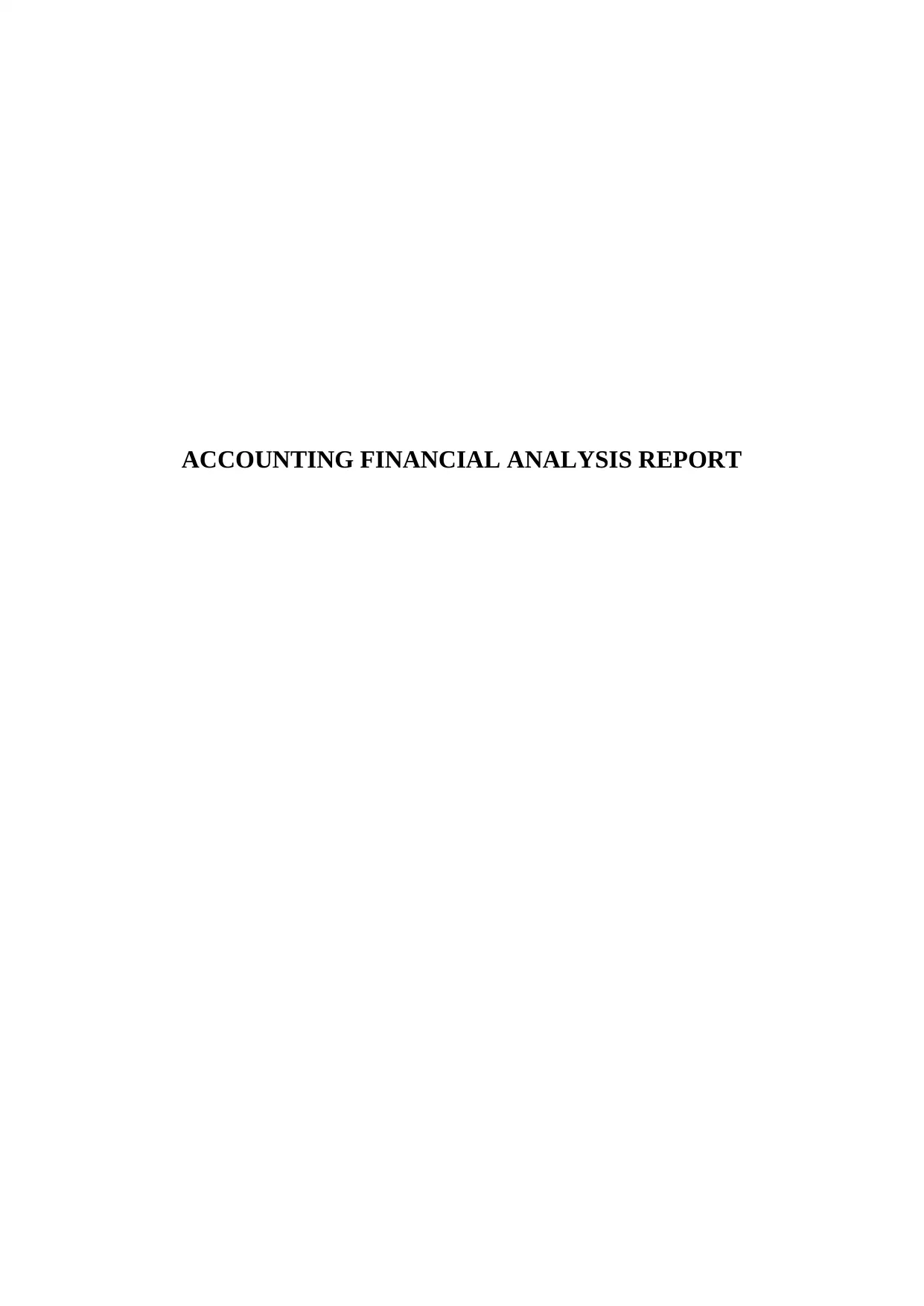
ACCOUNTING FINANCIAL ANALYSIS REPORT
Paraphrase This Document
Need a fresh take? Get an instant paraphrase of this document with our AI Paraphraser
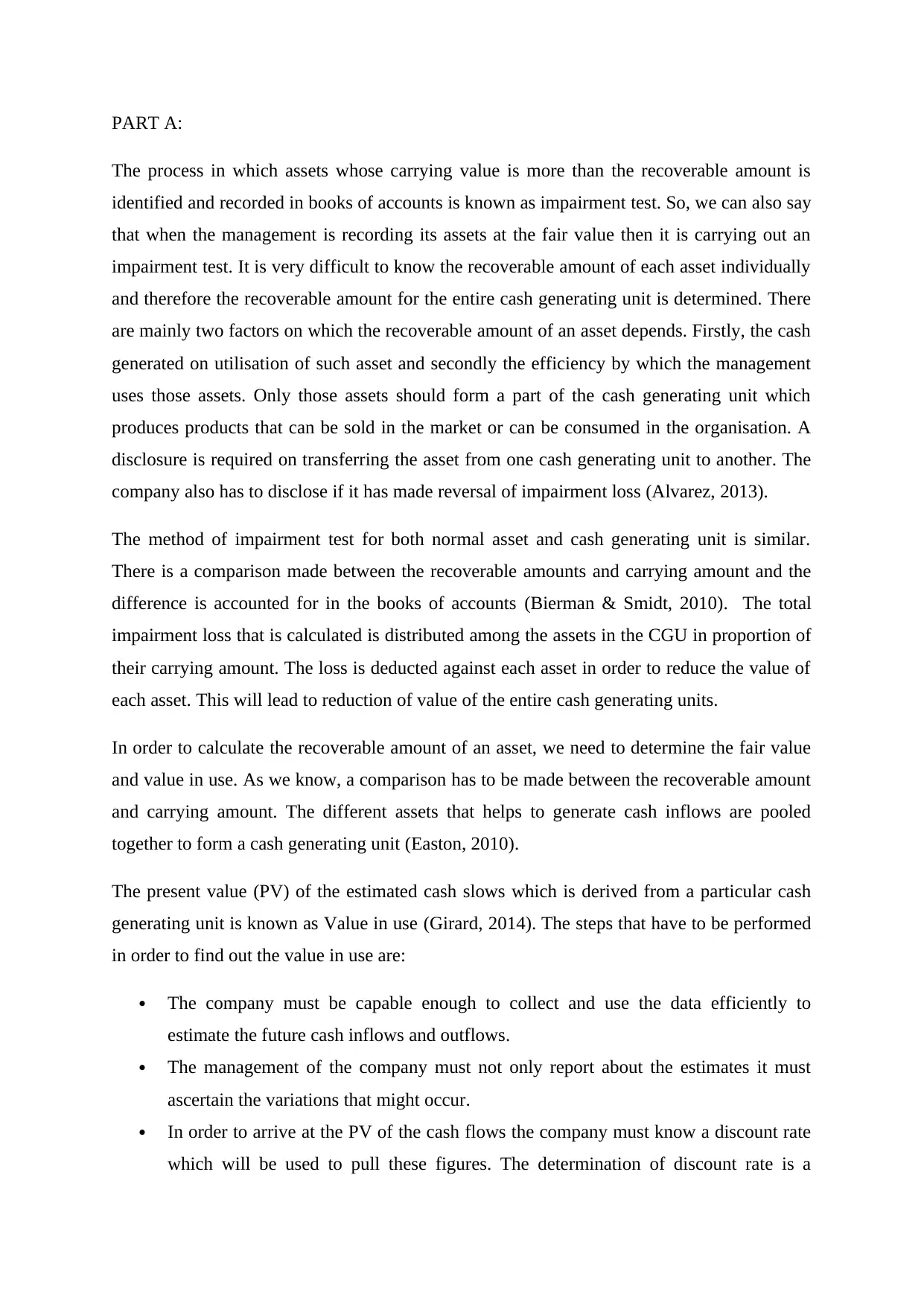
PART A:
The process in which assets whose carrying value is more than the recoverable amount is
identified and recorded in books of accounts is known as impairment test. So, we can also say
that when the management is recording its assets at the fair value then it is carrying out an
impairment test. It is very difficult to know the recoverable amount of each asset individually
and therefore the recoverable amount for the entire cash generating unit is determined. There
are mainly two factors on which the recoverable amount of an asset depends. Firstly, the cash
generated on utilisation of such asset and secondly the efficiency by which the management
uses those assets. Only those assets should form a part of the cash generating unit which
produces products that can be sold in the market or can be consumed in the organisation. A
disclosure is required on transferring the asset from one cash generating unit to another. The
company also has to disclose if it has made reversal of impairment loss (Alvarez, 2013).
The method of impairment test for both normal asset and cash generating unit is similar.
There is a comparison made between the recoverable amounts and carrying amount and the
difference is accounted for in the books of accounts (Bierman & Smidt, 2010). The total
impairment loss that is calculated is distributed among the assets in the CGU in proportion of
their carrying amount. The loss is deducted against each asset in order to reduce the value of
each asset. This will lead to reduction of value of the entire cash generating units.
In order to calculate the recoverable amount of an asset, we need to determine the fair value
and value in use. As we know, a comparison has to be made between the recoverable amount
and carrying amount. The different assets that helps to generate cash inflows are pooled
together to form a cash generating unit (Easton, 2010).
The present value (PV) of the estimated cash slows which is derived from a particular cash
generating unit is known as Value in use (Girard, 2014). The steps that have to be performed
in order to find out the value in use are:
The company must be capable enough to collect and use the data efficiently to
estimate the future cash inflows and outflows.
The management of the company must not only report about the estimates it must
ascertain the variations that might occur.
In order to arrive at the PV of the cash flows the company must know a discount rate
which will be used to pull these figures. The determination of discount rate is a
The process in which assets whose carrying value is more than the recoverable amount is
identified and recorded in books of accounts is known as impairment test. So, we can also say
that when the management is recording its assets at the fair value then it is carrying out an
impairment test. It is very difficult to know the recoverable amount of each asset individually
and therefore the recoverable amount for the entire cash generating unit is determined. There
are mainly two factors on which the recoverable amount of an asset depends. Firstly, the cash
generated on utilisation of such asset and secondly the efficiency by which the management
uses those assets. Only those assets should form a part of the cash generating unit which
produces products that can be sold in the market or can be consumed in the organisation. A
disclosure is required on transferring the asset from one cash generating unit to another. The
company also has to disclose if it has made reversal of impairment loss (Alvarez, 2013).
The method of impairment test for both normal asset and cash generating unit is similar.
There is a comparison made between the recoverable amounts and carrying amount and the
difference is accounted for in the books of accounts (Bierman & Smidt, 2010). The total
impairment loss that is calculated is distributed among the assets in the CGU in proportion of
their carrying amount. The loss is deducted against each asset in order to reduce the value of
each asset. This will lead to reduction of value of the entire cash generating units.
In order to calculate the recoverable amount of an asset, we need to determine the fair value
and value in use. As we know, a comparison has to be made between the recoverable amount
and carrying amount. The different assets that helps to generate cash inflows are pooled
together to form a cash generating unit (Easton, 2010).
The present value (PV) of the estimated cash slows which is derived from a particular cash
generating unit is known as Value in use (Girard, 2014). The steps that have to be performed
in order to find out the value in use are:
The company must be capable enough to collect and use the data efficiently to
estimate the future cash inflows and outflows.
The management of the company must not only report about the estimates it must
ascertain the variations that might occur.
In order to arrive at the PV of the cash flows the company must know a discount rate
which will be used to pull these figures. The determination of discount rate is a
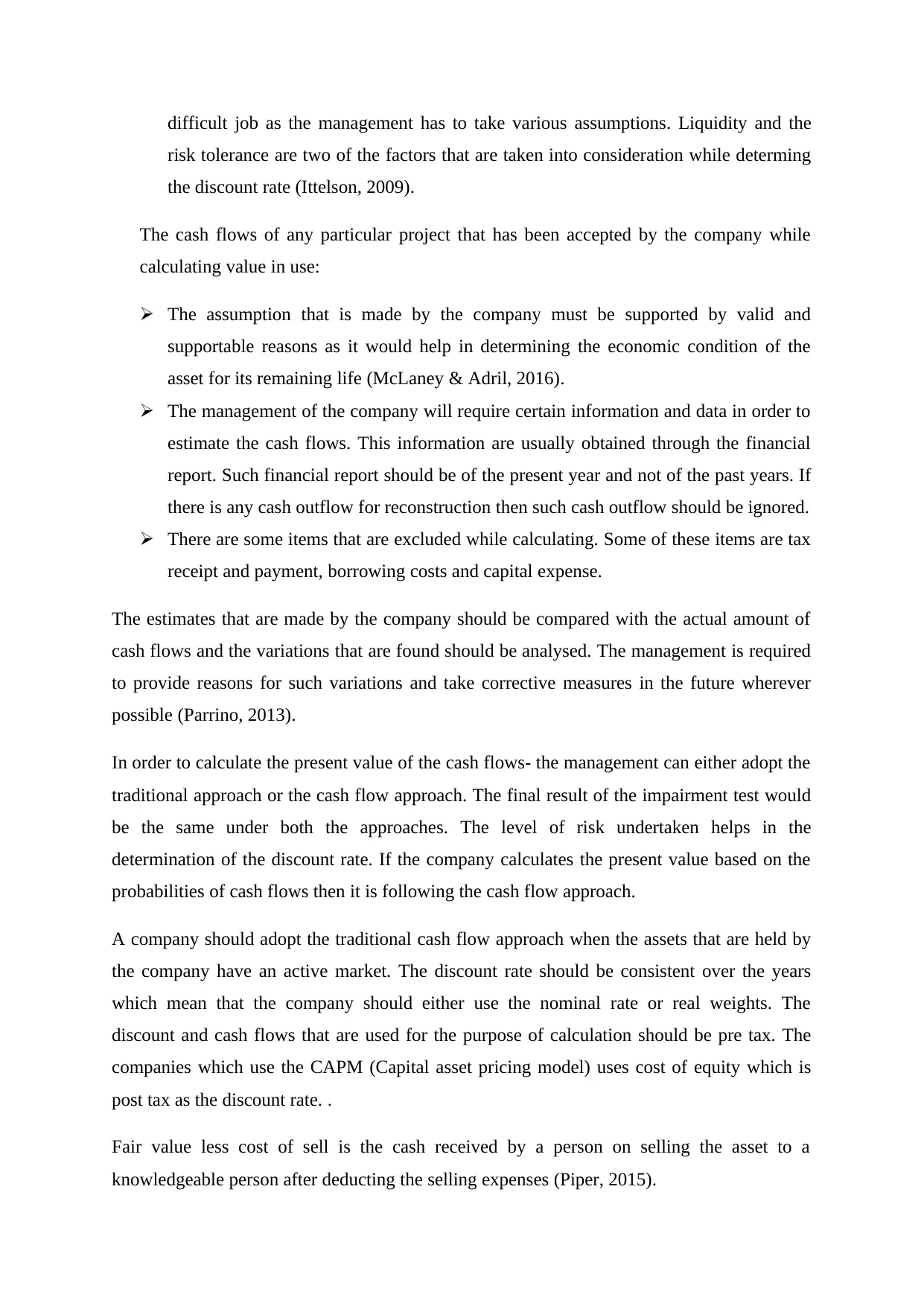
difficult job as the management has to take various assumptions. Liquidity and the
risk tolerance are two of the factors that are taken into consideration while determing
the discount rate (Ittelson, 2009).
The cash flows of any particular project that has been accepted by the company while
calculating value in use:
The assumption that is made by the company must be supported by valid and
supportable reasons as it would help in determining the economic condition of the
asset for its remaining life (McLaney & Adril, 2016).
The management of the company will require certain information and data in order to
estimate the cash flows. This information are usually obtained through the financial
report. Such financial report should be of the present year and not of the past years. If
there is any cash outflow for reconstruction then such cash outflow should be ignored.
There are some items that are excluded while calculating. Some of these items are tax
receipt and payment, borrowing costs and capital expense.
The estimates that are made by the company should be compared with the actual amount of
cash flows and the variations that are found should be analysed. The management is required
to provide reasons for such variations and take corrective measures in the future wherever
possible (Parrino, 2013).
In order to calculate the present value of the cash flows- the management can either adopt the
traditional approach or the cash flow approach. The final result of the impairment test would
be the same under both the approaches. The level of risk undertaken helps in the
determination of the discount rate. If the company calculates the present value based on the
probabilities of cash flows then it is following the cash flow approach.
A company should adopt the traditional cash flow approach when the assets that are held by
the company have an active market. The discount rate should be consistent over the years
which mean that the company should either use the nominal rate or real weights. The
discount and cash flows that are used for the purpose of calculation should be pre tax. The
companies which use the CAPM (Capital asset pricing model) uses cost of equity which is
post tax as the discount rate. .
Fair value less cost of sell is the cash received by a person on selling the asset to a
knowledgeable person after deducting the selling expenses (Piper, 2015).
risk tolerance are two of the factors that are taken into consideration while determing
the discount rate (Ittelson, 2009).
The cash flows of any particular project that has been accepted by the company while
calculating value in use:
The assumption that is made by the company must be supported by valid and
supportable reasons as it would help in determining the economic condition of the
asset for its remaining life (McLaney & Adril, 2016).
The management of the company will require certain information and data in order to
estimate the cash flows. This information are usually obtained through the financial
report. Such financial report should be of the present year and not of the past years. If
there is any cash outflow for reconstruction then such cash outflow should be ignored.
There are some items that are excluded while calculating. Some of these items are tax
receipt and payment, borrowing costs and capital expense.
The estimates that are made by the company should be compared with the actual amount of
cash flows and the variations that are found should be analysed. The management is required
to provide reasons for such variations and take corrective measures in the future wherever
possible (Parrino, 2013).
In order to calculate the present value of the cash flows- the management can either adopt the
traditional approach or the cash flow approach. The final result of the impairment test would
be the same under both the approaches. The level of risk undertaken helps in the
determination of the discount rate. If the company calculates the present value based on the
probabilities of cash flows then it is following the cash flow approach.
A company should adopt the traditional cash flow approach when the assets that are held by
the company have an active market. The discount rate should be consistent over the years
which mean that the company should either use the nominal rate or real weights. The
discount and cash flows that are used for the purpose of calculation should be pre tax. The
companies which use the CAPM (Capital asset pricing model) uses cost of equity which is
post tax as the discount rate. .
Fair value less cost of sell is the cash received by a person on selling the asset to a
knowledgeable person after deducting the selling expenses (Piper, 2015).
⊘ This is a preview!⊘
Do you want full access?
Subscribe today to unlock all pages.

Trusted by 1+ million students worldwide

The fair vale less cost of sell is the amount that is already mentioned in the sales
agreement. However, if there is any incremental cost then it should be taken into
consideration.
If there is no sales agreement present then the market price of such asset is determined
and the cost of disposal is deducted.
If there is no sales agreement and also it is not possible to ascertain the market price
then the company must look upon the cash flow that will be generated from the asset
at the end of the period.
As we know, risk and uncertainties are not predictable and change from time to time. So, the
company must make the required changes in the discount rate and the cash flows based on
such changes. Economy and business activities are dynamic in nature so the assumptions
taken also has to change from one time period to another which would result in change of
discount rate.
agreement. However, if there is any incremental cost then it should be taken into
consideration.
If there is no sales agreement present then the market price of such asset is determined
and the cost of disposal is deducted.
If there is no sales agreement and also it is not possible to ascertain the market price
then the company must look upon the cash flow that will be generated from the asset
at the end of the period.
As we know, risk and uncertainties are not predictable and change from time to time. So, the
company must make the required changes in the discount rate and the cash flows based on
such changes. Economy and business activities are dynamic in nature so the assumptions
taken also has to change from one time period to another which would result in change of
discount rate.
Paraphrase This Document
Need a fresh take? Get an instant paraphrase of this document with our AI Paraphraser
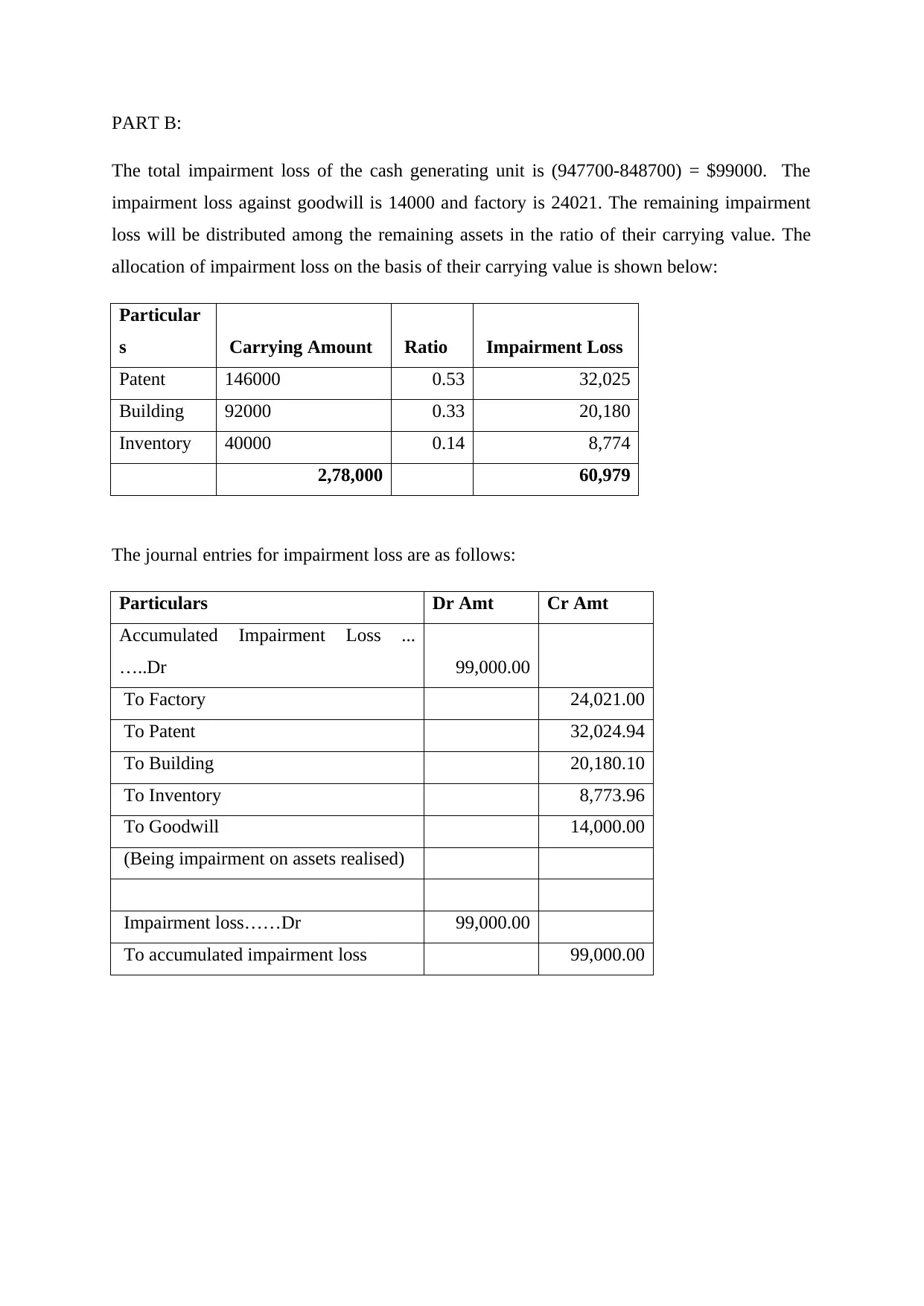
PART B:
The total impairment loss of the cash generating unit is (947700-848700) = $99000. The
impairment loss against goodwill is 14000 and factory is 24021. The remaining impairment
loss will be distributed among the remaining assets in the ratio of their carrying value. The
allocation of impairment loss on the basis of their carrying value is shown below:
Particular
s Carrying Amount Ratio Impairment Loss
Patent 146000 0.53 32,025
Building 92000 0.33 20,180
Inventory 40000 0.14 8,774
2,78,000 60,979
The journal entries for impairment loss are as follows:
Particulars Dr Amt Cr Amt
Accumulated Impairment Loss ...
…..Dr 99,000.00
To Factory 24,021.00
To Patent 32,024.94
To Building 20,180.10
To Inventory 8,773.96
To Goodwill 14,000.00
(Being impairment on assets realised)
Impairment loss……Dr 99,000.00
To accumulated impairment loss 99,000.00
The total impairment loss of the cash generating unit is (947700-848700) = $99000. The
impairment loss against goodwill is 14000 and factory is 24021. The remaining impairment
loss will be distributed among the remaining assets in the ratio of their carrying value. The
allocation of impairment loss on the basis of their carrying value is shown below:
Particular
s Carrying Amount Ratio Impairment Loss
Patent 146000 0.53 32,025
Building 92000 0.33 20,180
Inventory 40000 0.14 8,774
2,78,000 60,979
The journal entries for impairment loss are as follows:
Particulars Dr Amt Cr Amt
Accumulated Impairment Loss ...
…..Dr 99,000.00
To Factory 24,021.00
To Patent 32,024.94
To Building 20,180.10
To Inventory 8,773.96
To Goodwill 14,000.00
(Being impairment on assets realised)
Impairment loss……Dr 99,000.00
To accumulated impairment loss 99,000.00
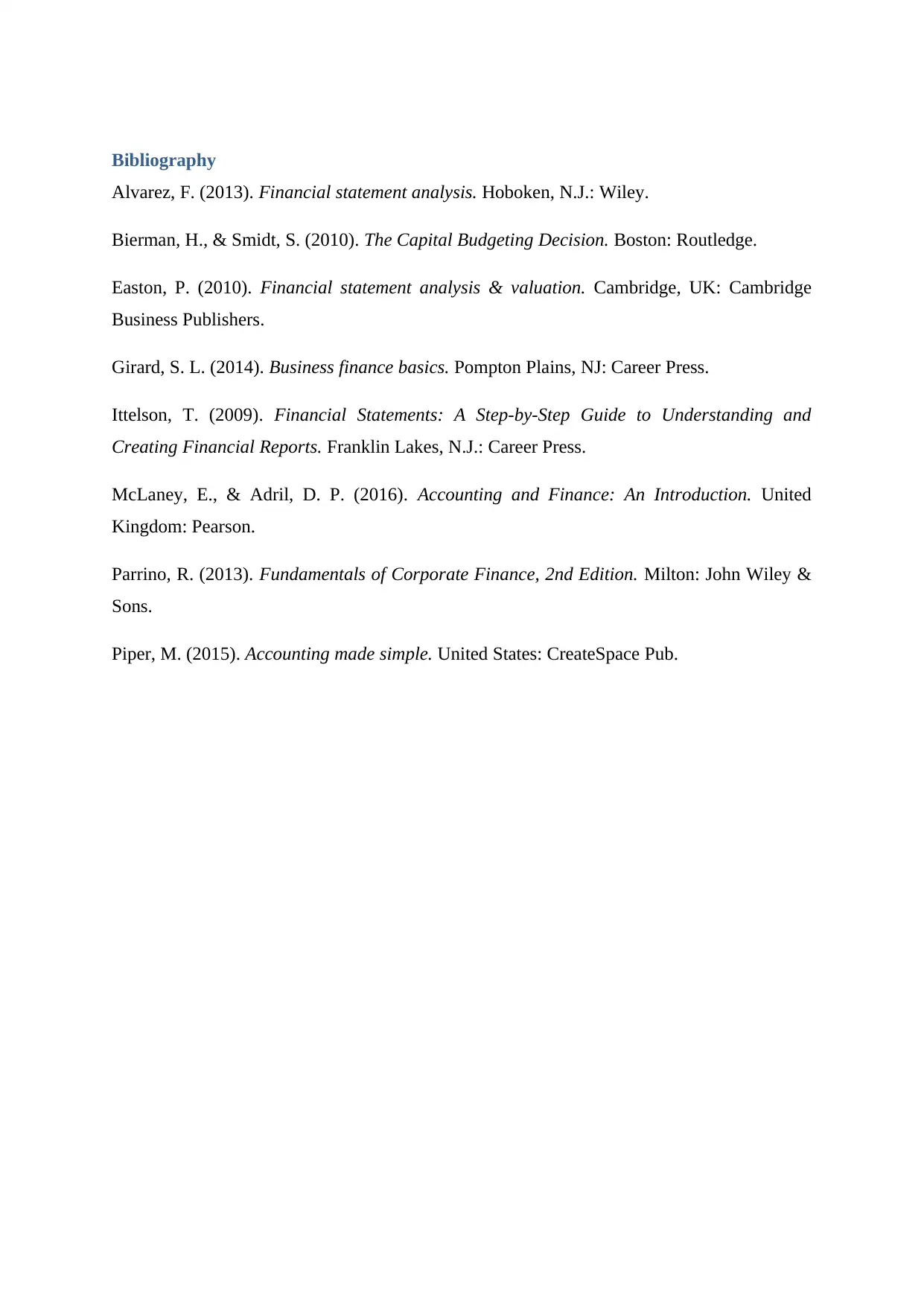
Bibliography
Alvarez, F. (2013). Financial statement analysis. Hoboken, N.J.: Wiley.
Bierman, H., & Smidt, S. (2010). The Capital Budgeting Decision. Boston: Routledge.
Easton, P. (2010). Financial statement analysis & valuation. Cambridge, UK: Cambridge
Business Publishers.
Girard, S. L. (2014). Business finance basics. Pompton Plains, NJ: Career Press.
Ittelson, T. (2009). Financial Statements: A Step-by-Step Guide to Understanding and
Creating Financial Reports. Franklin Lakes, N.J.: Career Press.
McLaney, E., & Adril, D. P. (2016). Accounting and Finance: An Introduction. United
Kingdom: Pearson.
Parrino, R. (2013). Fundamentals of Corporate Finance, 2nd Edition. Milton: John Wiley &
Sons.
Piper, M. (2015). Accounting made simple. United States: CreateSpace Pub.
Alvarez, F. (2013). Financial statement analysis. Hoboken, N.J.: Wiley.
Bierman, H., & Smidt, S. (2010). The Capital Budgeting Decision. Boston: Routledge.
Easton, P. (2010). Financial statement analysis & valuation. Cambridge, UK: Cambridge
Business Publishers.
Girard, S. L. (2014). Business finance basics. Pompton Plains, NJ: Career Press.
Ittelson, T. (2009). Financial Statements: A Step-by-Step Guide to Understanding and
Creating Financial Reports. Franklin Lakes, N.J.: Career Press.
McLaney, E., & Adril, D. P. (2016). Accounting and Finance: An Introduction. United
Kingdom: Pearson.
Parrino, R. (2013). Fundamentals of Corporate Finance, 2nd Edition. Milton: John Wiley &
Sons.
Piper, M. (2015). Accounting made simple. United States: CreateSpace Pub.
⊘ This is a preview!⊘
Do you want full access?
Subscribe today to unlock all pages.

Trusted by 1+ million students worldwide
1 out of 6
Related Documents
Your All-in-One AI-Powered Toolkit for Academic Success.
+13062052269
info@desklib.com
Available 24*7 on WhatsApp / Email
![[object Object]](/_next/static/media/star-bottom.7253800d.svg)
Unlock your academic potential
Copyright © 2020–2025 A2Z Services. All Rights Reserved. Developed and managed by ZUCOL.





